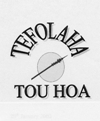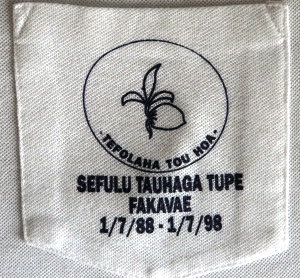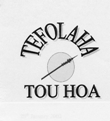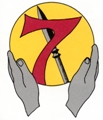
| |
| HOME |
| about this Site |
| photos |
| genealogies |
| faiga mo iloga project |
| nanufuti update |
| nanumea abroad |
| mea taaua |
| writings and resources |
| links to other Tuvalu and Pacific websites |
| contact Kiti mo Ane |
THE KAUMAILE |
|
The Kaumaile is a renowned treasure, central to Nanumean traditional history. This heavy wooden spear, about 1.8m long, is carved from a very dense, blackish brown, fine-grained wood. The Kaumaile is believed to have been brought to Nanumea by Tefolaha, the community's founder, who had used it in battles in Samoa and Tonga. Upon Tefolaha's death, the spear passed to his descendants, including Lapi. Lapi is believed to have used the Kaumaile to defeat the giant, Tuulapoupou, calling on the spirit of Tefohaha to help him -- Tefolaha Tou Hoa! The Kaumaile has come down to us today in the possession of descendants of Lapi. In 1974 it was held in trust for Nanumea by Seselo, who had received it from his adoptive father, Manuella. There is an interesting story about Manuella and the Kaumaile. We heard this story from five or six different elders in Nanumea in 1973-74, including Kaifou, Seselo and Tulaga Manuella. Tulaga had also been adopted by Manuella and was Seselo’s brother: The Kaumaile Goes to England In about 1936 or 1937 Kaifou (who told us about this incident on November 4, 1974), Tulo and Manuella were working at the phosphate works on Banaba -- they had gone in the recruitment malaga from Nanumea in 1936. The Kaumaile spear was noticed by Manuella in the office of a Mr. Barley (Tulaga Manuella named this man as Mr. McClure). In any case, one of the British mine managers had the spear. Manuella, as a descendant of Teuki, the man who had given the Kaumaile to Misi Lusi, reclaimed the spear and returned it to Nanumea in the late 1930's. It has remained there to this day, carefully cared for as the community’s most precious ancestral relic. It is not clear why Nanumeans were willing to give the spear up in the first place, but Seselo thought it likely that by doing this they hoped to get further information about its age and origins from the officials. In 1974, Seselo told us that while the Kaumaile was in England it was tested and found to be about 800 years old. He did not’t know any more details about what the testing involved or who did it. Again during our research in Nanumea in 1984, people hoped we could find additional information about the Kaumaile. Following our first stay in Nanumea we'd been able to examine missionary and colonial accounts for information, but had found nothing about the spear. Later in 1984 we looked through the spear collection in the B.P. Bishop Museum in Honolulu, searching for spears from other parts of the Pacific that looked similar to the Kaumaile. We hoped this might help estimate the spear's age, and also where it may have originated, since Nanumeans were certain that its wood did not come from any tree presently existing on the island. None of the Polynesian spears we saw at the Bishop Museum were exactly like the Kaumaile, though the flared blade and raised welts where the handle widens into the blade were somewhat similar to those from the Society Islands (Bishop Museum item C306). Spears similar to these are shown in the publication entitled Polynesian Artifacts: The Oldman Collection, published by the Polynesian Society, Wellington (its Memoirs series, volume 15, 2nd edition, 1953, plates 33 and 34). Spears from Niue and the Austral Islands in the Bishop Museum also seemed similar to the Kaumaile. There was nothing identical to it in the collection, however. In 2004, the topic of Nanumean treasures given to or taken away by outsiders in the past came up again during our visit. We knew from our reading about one such item, an ancient orator’s staff which was given to LMS missionary George A Turner in July, 1874. Turner was told that this staff, described as made of toa wood and being ancient and patched-looking, had been brought to Nanumea from Samoa at the time of the island’s settlement by “the father of the Nanumeans [that is, no doubt, Tefolaha].” We began to wonder if any items from Nanumea had made their way to museums in England. Later in 2004, on a visit to London, we made an appointment to see the Tuvalu collections at the British Museum. Though we were shown a variety of Tuvaluan items stored there (including titi and necklaces), we found no staffs or spears. We hope that one day it will be possible to trace the whereabouts of Tefolaha’s orator’s staff, which may still exist in some part of the world. (To see some photos of Tuvaluan items in the British Museum collection, click the link below) Carbon Dating the Kaumaile Heather recalls that she first discussed the possibility of using Carbon-14 dating to determine the Kaumaile's age with Dr. Tiliga Pulusi and his family. Fale Kaupule leaders were interested too, so Heather agreed to find out how testing could be done. The information she received from a laboratory indicated that a small sliver of wood would have to be removed from the spear and sent to a laboratory overseas. After much thought and discussion in meetings in the ahiga, Nanumean leaders decided to proceed and authorized that the required sample be obtained. On September 29, 2006, the spear was brought to the island clinic near Dr. Tiliga's house and Apinelu Tiliga and Timi Melei, with Heather looking on, used a sterile knife to remove a small sliver of wood from near the Kaumaile's base. This sample, smaller than a wooden matchstick and carefully stored in a sterile glass vial, was taken by Heather to New Zealand in November, 2006. Rafter Radiocarbon Laboratory, a division of GNS Science located in Lower
Hutt, New Zealand, had facilities to do the sophisticated carbon-14 The test was done February 7, 2007, paid for with funds from Nanumea's Kaupule. By this time, Heather was back in the USA, continuing her graduate studies. The lab forwarded her the results and she immediately wrote a description of the process and sent this and the laboratory report to Nanumea and to Nanufuti leaders in Funafuti. How Old is The Kaumaile? The tests showed that the Kaumaile is approximately 880 years old. In the language of the technical report, its age dates to 880 years "BP", before the present. Subtracting 880 years from 2007, the year in which the testing was done, provides us a date -- the Kaumaile is known to be made from a tree that was last alive in about 1127 A.D. Nanumea's ancestral relic is indeed very ancient -- extraordinarily so. Nanumeans have managed to care for and preserve an important piece of the past for nearly a thousand years, and today all Nanumeans can, if they are in Nanumea, see this remarkable object. Click here to see Heather Lazrus' letter to Nanumea about the Kaumaile laboratory results. The full Laboratory Carbon Dating Report is also here. Heather's original letter was translated into Nanumean by Lopati Samsoni. There are several important things to remember about this information: 2) what kind of tree the spear is made from, and where it may grow, is not yet known. The laboratory was unable to do this type of testing. Some of the original wood sample still exists and it might be possible to do further tests in future to determine the species of tree the Kaumaile was made from. 3) The age of 880 years old is the age of the wood, not specifically the age of spear. This means that the wood was part of a living tree about 880 years ago. Of course, we cannot be sure the spear was made as soon as the tree was cut. Just as with wood that floats ashore in Tuvalu and is used for building things, the date of the wood and the date it was used to make something can vary. However, it seems likely that the Kaumaile would have been made from recently harvested wood, and thus we can reasonably accept its age as 880 years old. Truly ancient, as Nanumeans have believed all along. A Thousand Year Old Treasure Laboratory Carbon Dating Report (pdf) Heather Lazrus' Letter with Test Results -- as faxed to Nanumea (translated by Lopati Samsoni -pdf)Photos of items in Tuvalu collection, British Museum, London Back to Top
|
Seselo Manuella with the Kaumaile |
||
|
The saying "Tefolaha Tou Hoa" has been handed down from the time of Lapi, who had been given instructions by the spirit of Tefolaha on how to use the words and the spear. Since the time when Tuulapoupou was defeated on Nanumea's south-western reef flat, these words have had magical power for Nanumeans. They can be used when one is in danger, even if one only thinks them. Nanumeans often honor Tefolaha when they drink pi (drinking nuts) or kaleve (coconut sap) by pouring out the last bit of liquid on the ground, and saying "Tefolaha Tou Hoa." (This information on Lapi and the magical phrase from Tefolaha came from Maheu Naniseni and Venu Kelese in 1974) The emblem with this saying and a drawing of the Kaumaile in the center comes from the letterhead paper of Nanufuti community in Funafuti - fakafetai Nanufuti!   Tefolaha Tou Hoa on Tupe Fakavae Shirt - Nanufuti 1998 Back to Top |
||

